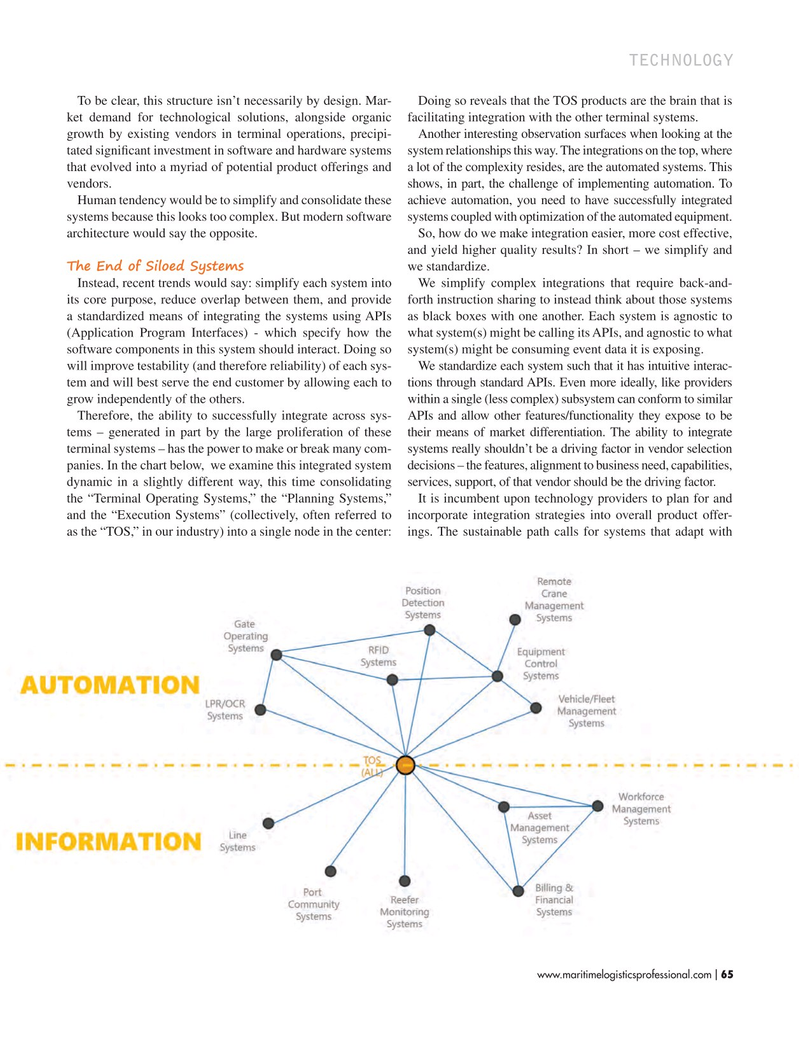
Page 65: of Maritime Logistics Professional Magazine (Jul/Aug 2017)
PORTS & INFRASTRUCTURE
Read this page in Pdf, Flash or Html5 edition of Jul/Aug 2017 Maritime Logistics Professional Magazine
TECHNOLOGY
To be clear, this structure isn’t necessarily by design. Mar- Doing so reveals that the TOS products are the brain that is ket demand for technological solutions, alongside organic facilitating integration with the other terminal systems. growth by existing vendors in terminal operations, precipi- Another interesting observation surfaces when looking at the tated signifcant investment in software and hardware systems system relationships this way. The integrations on the top, where that evolved into a myriad of potential product offerings and a lot of the complexity resides, are the automated systems. This vendors. shows, in part, the challenge of implementing automation. To
Human tendency would be to simplify and consolidate these achieve automation, you need to have successfully integrated systems because this looks too complex. But modern software systems coupled with optimization of the automated equipment. architecture would say the opposite. So, how do we make integration easier, more cost effective, and yield higher quality results? In short – we simplify and
The End of Siloed Systems we standardize.
Instead, recent trends would say: simplify each system into We simplify complex integrations that require back-and- its core purpose, reduce overlap between them, and provide forth instruction sharing to instead think about those systems a standardized means of integrating the systems using APIs as black boxes with one another. Each system is agnostic to (Application Program Interfaces) - which specify how the what system(s) might be calling its APIs, and agnostic to what software components in this system should interact. Doing so system(s) might be consuming event data it is exposing.
will improve testability (and therefore reliability) of each sys- We standardize each system such that it has intuitive interac- tem and will best serve the end customer by allowing each to tions through standard APIs. Even more ideally, like providers grow independently of the others. within a single (less complex) subsystem can conform to similar
Therefore, the ability to successfully integrate across sys- APIs and allow other features/functionality they expose to be tems – generated in part by the large proliferation of these their means of market differentiation. The ability to integrate terminal systems – has the power to make or break many com- systems really shouldn’t be a driving factor in vendor selection panies. In the chart below, we examine this integrated system decisions – the features, alignment to business need, capabilities, dynamic in a slightly different way, this time consolidating services, support, of that vendor should be the driving factor.
the “Terminal Operating Systems,” the “Planning Systems,” It is incumbent upon technology providers to plan for and and the “Execution Systems” (collectively, often referred to incorporate integration strategies into overall product offer- as the “TOS,” in our industry) into a single node in the center: ings. The sustainable path calls for systems that adapt with www.maritimelogisticsprofessional.com 65
I

 64
64

 66
66
